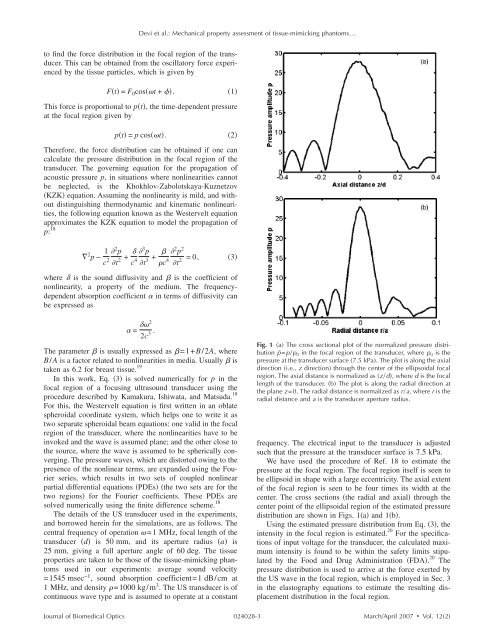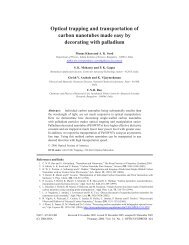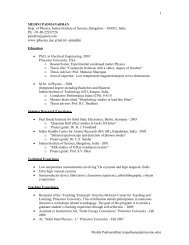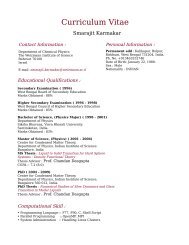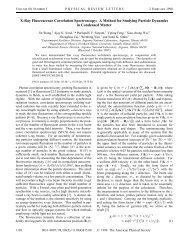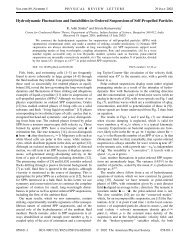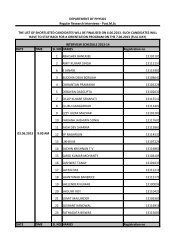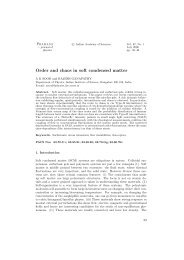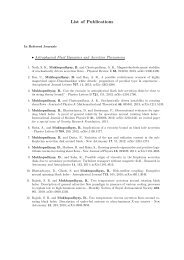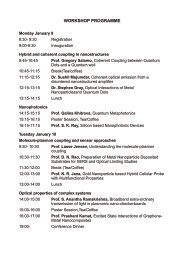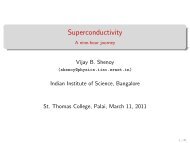C. Usha Devi, R. S. Bharat Chandran, R. M. Vasu and A.K. ... - Physics
C. Usha Devi, R. S. Bharat Chandran, R. M. Vasu and A.K. ... - Physics
C. Usha Devi, R. S. Bharat Chandran, R. M. Vasu and A.K. ... - Physics
You also want an ePaper? Increase the reach of your titles
YUMPU automatically turns print PDFs into web optimized ePapers that Google loves.
<strong>Devi</strong> et al.: Mechanical property assessment of tissue-mimicking phantoms…<br />
to find the force distribution in the focal region of the transducer.<br />
This can be obtained from the oscillatory force experienced<br />
by the tissue particles, which is given by<br />
Ft = F 0 cost + .<br />
This force is proportional to pt, the time-dependent pressure<br />
at the focal region given by<br />
pt = p cost.<br />
Therefore, the force distribution can be obtained if one can<br />
calculate the pressure distribution in the focal region of the<br />
transducer. The governing equation for the propagation of<br />
acoustic pressure p, in situations where nonlinearities cannot<br />
be neglected, is the Khokhlov-Zabolotskaya-Kuznetzov<br />
KZK equation. Assuming the nonlinearity is mild, <strong>and</strong> without<br />
distinguishing thermodynamic <strong>and</strong> kinematic nonlinearities,<br />
the following equation known as the Westervelt equation<br />
approximates the KZK equation to model the propagation of<br />
p: 18 2 p − 1 2 p<br />
c 2 t 2 + 3 p<br />
c 4 t 3 + 2 p 2<br />
c 4 2<br />
=0, 3<br />
t<br />
where is the sound diffusivity <strong>and</strong> is the coefficient of<br />
nonlinearity, a property of the medium. The frequencydependent<br />
absorption coefficient in terms of diffusivity can<br />
be expressed as<br />
1<br />
2<br />
= 2<br />
2c 3 .<br />
The parameter is usually expressed as =1+B/2A, where<br />
B/A is a factor related to nonlinearities in media. Usually is<br />
taken as 6.2 for breast tissue. 19<br />
In this work, Eq. 3 is solved numerically for p in the<br />
focal region of a focusing ultrasound transducer using the<br />
procedure described by Kamakura, Ishiwata, <strong>and</strong> Matsuda. 18<br />
For this, the Westervelt equation is first written in an oblate<br />
spheroidal coordinate system, which helps one to write it as<br />
two separate spheroidal beam equations: one valid in the focal<br />
region of the transducer, where the nonlinearities have to be<br />
invoked <strong>and</strong> the wave is assumed plane; <strong>and</strong> the other close to<br />
the source, where the wave is assumed to be spherically converging.<br />
The pressure waves, which are distorted owing to the<br />
presence of the nonlinear terms, are exp<strong>and</strong>ed using the Fourier<br />
series, which results in two sets of coupled nonlinear<br />
partial differential equations PDEs the two sets are for the<br />
two regions for the Fourier coefficients. These PDEs are<br />
solved numerically using the finite difference scheme. 18<br />
The details of the US transducer used in the experiments,<br />
<strong>and</strong> borrowed herein for the simulations, are as follows. The<br />
central frequency of operation =1 MHz, focal length of the<br />
transducer d is 50 mm, <strong>and</strong> its aperture radius a is<br />
25 mm, giving a full aperture angle of 60 deg. The tissue<br />
properties are taken to be those of the tissue-mimicking phantoms<br />
used in our experiments: average sound velocity<br />
=1545 msec −1 , sound absorption coefficient=1 dB/cm at<br />
1 MHz, <strong>and</strong> density =1000 kg/m 3 . The US transducer is of<br />
continuous wave type <strong>and</strong> is assumed to operate at a constant<br />
Fig. 1 a The cross sectional plot of the normalized pressure distribution<br />
p¯ =p/p 0 in the focal region of the transducer, where p 0 is the<br />
pressure at the transducer surface 7.5 kPa. The plot is along the axial<br />
direction i.e., z direction through the center of the ellipsoidal focal<br />
region. The axial distance is normalized as z/d, where d is the focal<br />
length of the transducer. b The plot is along the radial direction at<br />
the plane z=0. The radial distance is normalized as r/a, where r is the<br />
radial distance <strong>and</strong> a is the transducer aperture radius.<br />
frequency. The electrical input to the transducer is adjusted<br />
such that the pressure at the transducer surface is 7.5 kPa.<br />
We have used the procedure of Ref. 18 to estimate the<br />
pressure at the focal region. The focal region itself is seen to<br />
be ellipsoid in shape with a large eccentricity. The axial extent<br />
of the focal region is seen to be four times its width at the<br />
center. The cross sections the radial <strong>and</strong> axial through the<br />
center point of the ellipsoidal region of the estimated pressure<br />
distribution are shown in Figs. 1a <strong>and</strong> 1b.<br />
Using the estimated pressure distribution from Eq. 3, the<br />
intensity in the focal region is estimated. 20 For the specifications<br />
of input voltage for the transducer, the calculated maximum<br />
intensity is found to be within the safety limits stipulated<br />
by the Food <strong>and</strong> Drug Administration FDA. 20 The<br />
pressure distribution is used to arrive at the force exerted by<br />
the US wave in the focal region, which is employed in Sec. 3<br />
in the elastography equations to estimate the resulting displacement<br />
distribution in the focal region.<br />
Journal of Biomedical Optics 024028-3<br />
March/April 2007 Vol. 122


